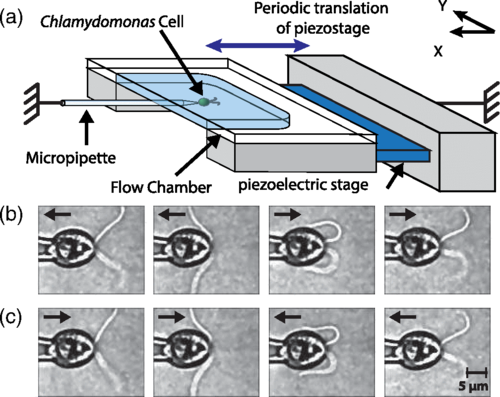December 8, 2015 report
Study suggests synchronization of algae flagella while swimming not driven by hydrodynamic forces

(Phys.org)—A team of researchers with Delft University in the Netherlands has found via lab experiments, that synchronization that occurs with algae flagella while they swim is likely not driven by hydrodynamic forces. In their paper published in Physical Review Letters, the researchers describe their experiments and observations and why they believe that what they saw helps explain how flagella synchronization in microorganisms works in general. Marco Polin with the University of Warwick in the U.K. offers a Viewpoint piece on the work done by the team in the same journal issue.
Most people have seen video of microorganisms in motion, some have short filaments known as cilia that cover their outer edges causing movement of the organism or the fluid in which they exist. Others such as the unicellular microalga Chlamydomonas reinhardtii, have longer appendages known as flagella, which are flexible rods protruding from the front of the body. C. reinhardtii uses its two flagella to swim through liquid, breaststroke style, which means the appendages must be synchronized—but what mechanism allows this synchronization to occur? Scientists do not know but have suspected it has to do with hydrodynamic forces, meaning the movement of the fluid causes it to come about. In this new effort, the researchers report that experiments they have carried out suggest such assumptions have been wrong, and that the synchronization comes about at least in part due to contractile fibers that connect the two flagella together.
The first experiment conducted by the team consisted of placing C. reinhardtii samples in a pipette and then filming the microorganisms as the liquid in which they were swimming inside was sloshed back and forth at varying intensities. The team reports that the flagella initially synchronized with the flow of the fluid, but only up to a point, at which it could not keep up as the slosh rate was increased. They noted also that the rate at which the flagellum beat individually in isolation from its normal partner varied by amounts up to 30 percent, but the two still synchronized when working together. They then calculated that if hydrodynamic forces alone were causing the synchronization, the flagella would have to produce a flow 30 times the normal swim speed of the microorganism to account for such a difference, thus, such forces do not appear to be the answer.
The team also looked at mutant samples of C. reinhardtii which did not have a band of contractile fibers connecting the flagella inside their bodies as is normal for the algae and found the flagella did not synchronize. This they claim, suggests that the fibers are somehow causing or allowing the synchronization to occur.
More information: Greta Quaranta et al. Hydrodynamics Versus Intracellular Coupling in the Synchronization of Eukaryotic Flagella, Physical Review Letters (2015). DOI: 10.1103/PhysRevLett.115.238101
ABSTRACT
The influence of hydrodynamic forces on eukaryotic flagella synchronization is investigated by triggering phase locking between a controlled external flow and the flagella of C. reinhardtii. Hydrodynamic forces required for synchronization are over an order of magnitude larger than hydrodynamic forces experienced in physiological conditions. Our results suggest that synchronization is due instead to coupling through cell internal fibers connecting the flagella. This conclusion is confirmed by observations of the vfl3 mutant, with impaired mechanical connection between the flagella.
Journal information: Physical Review Letters
© 2015 Phys.org



















